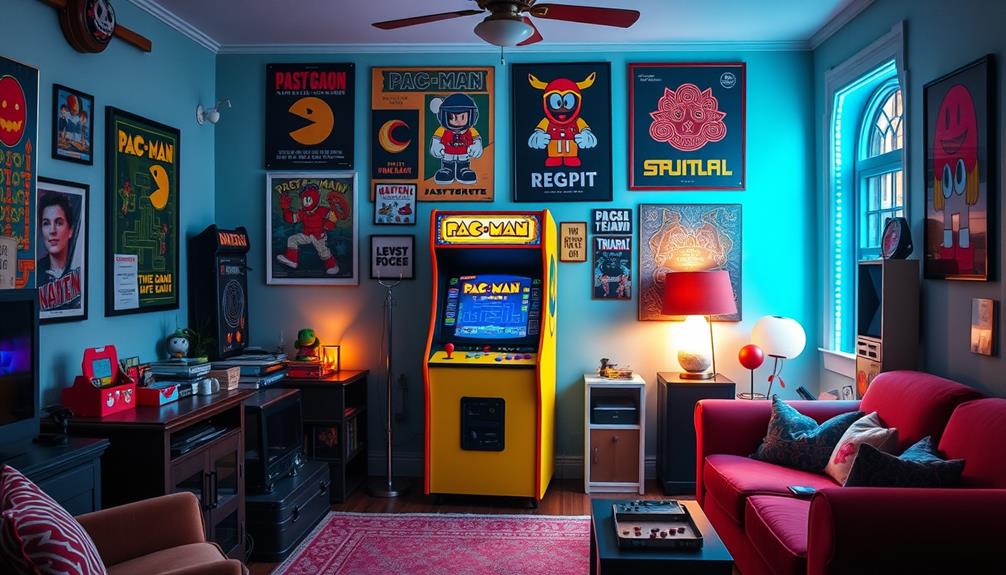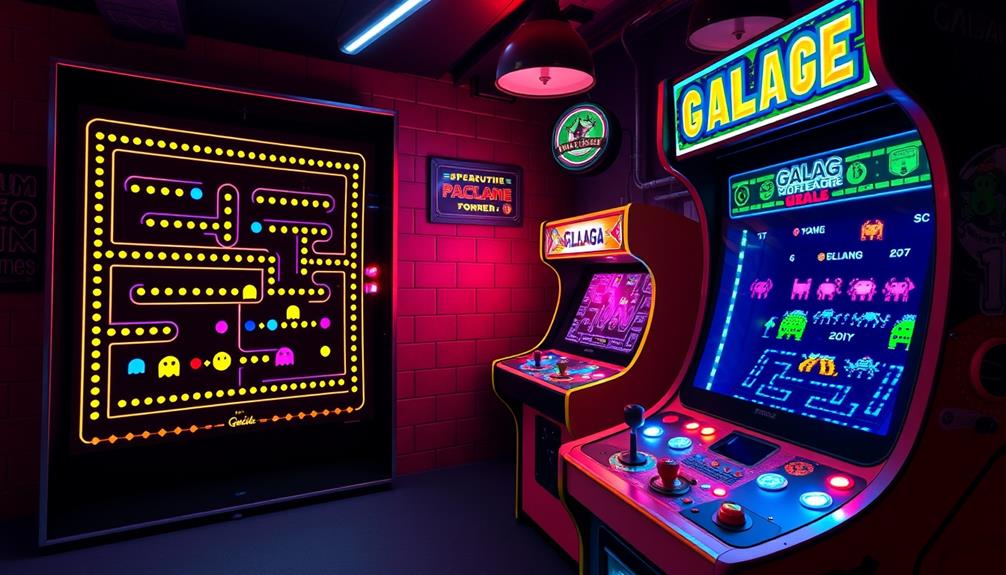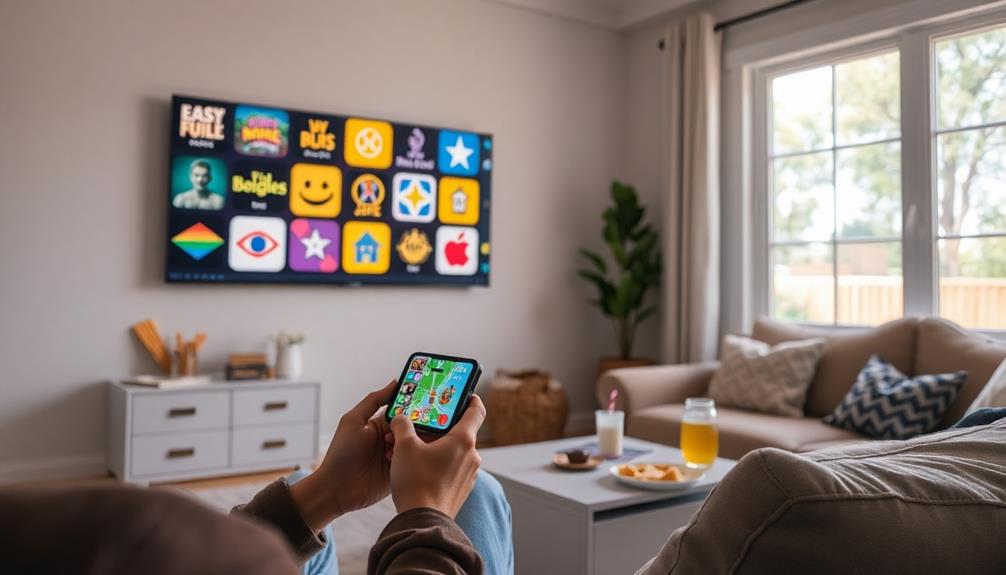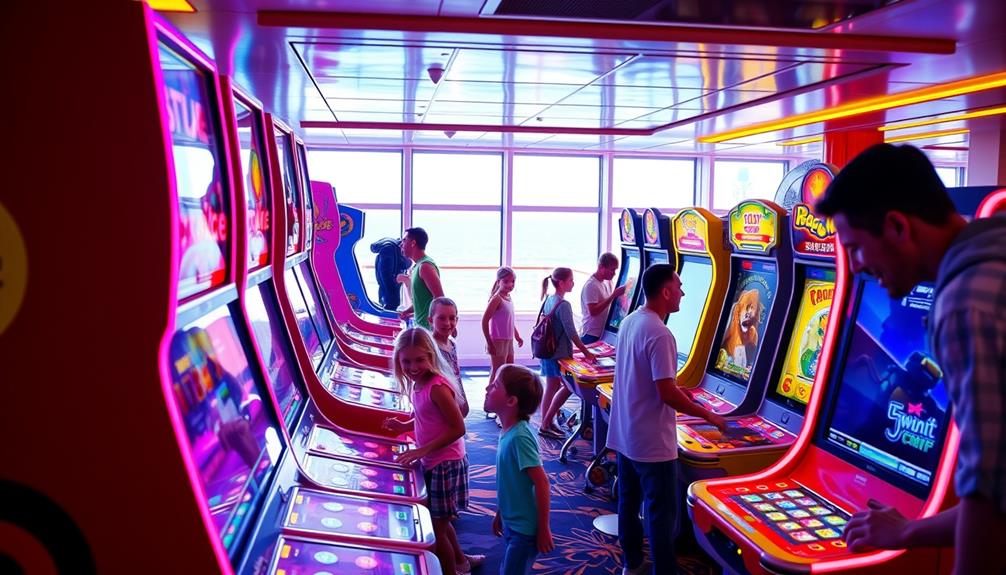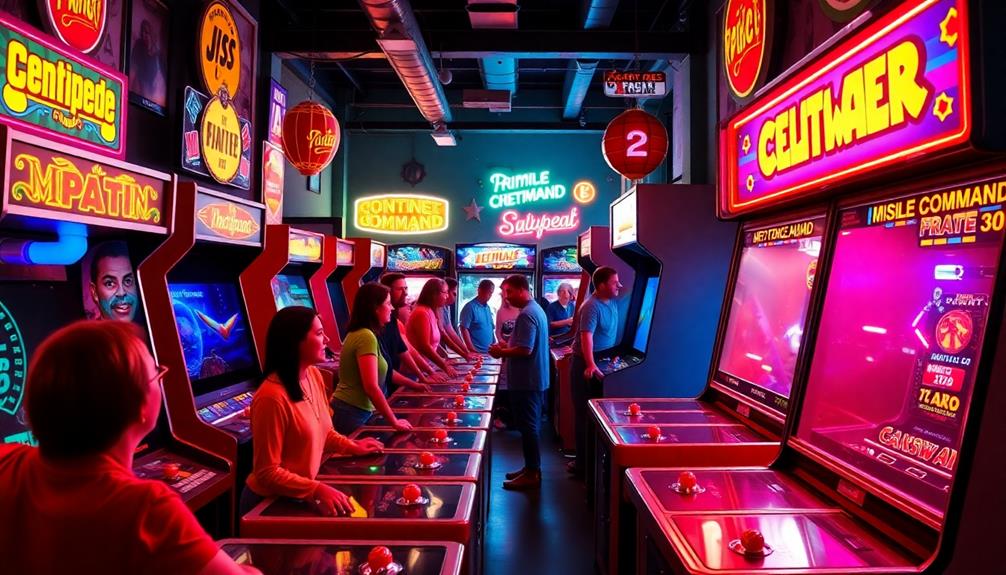If you are interested in old arcade games, you absolutely must check out iconic titles like Pac-Man and Donkey Kong. Pac-Man quickly became a cultural sensation with its maze chase gameplay, while Donkey Kong introduced players to Mario and paved the way for platformers. Space Invaders, a groundbreaking shooter game, challenged players to survive waves of alien attacks. Galaga offered exciting gameplay by allowing players to rescue captured ships. Other unforgettable titles include Ms. Pac-Man, R-Type, and House of the Dead 2. Each game has played a significant role in shaping the history of arcade gaming, and there is still much to discover about these legendary titles and their influence!
Key Takeaways
- Pac-Man (1980): A maze chase game that became a cultural phenomenon, influencing gaming culture and selling over 400,000 cabinets.
- Donkey Kong (1981): Introduced Mario and set the standard for platformers with innovative design involving ladders and obstacles.
- Space Invaders (1978): The first major shooter game, challenging players to defeat waves of aliens and popularizing arcade gaming.
- Galaga (1981): A sequel to Galaxian, featuring engaging shooter gameplay with unique mechanics like tractor beams and ship rescues.
- Ms. Pac-Man: An enhanced version of Pac-Man, introducing new mazes and randomized ghost movements, solidifying its place in arcade history.
Iconic Arcade Games
When you think back on the golden age of arcade gaming, several iconic titles come to mind that truly shaped the landscape of entertainment. One of the most recognizable is Pac-Man, released in 1980. This maze chase game not only captivated players but also became a cultural phenomenon, selling over 400,000 cabinets and grossing more than $1 billion by 1981.
Following closely is Donkey Kong from 1981, a groundbreaking platform game that introduced Mario and set the standard for future platformers with its innovative design featuring ladders and obstacles. The success of these games paved the way for many modern arcade machines, which often include top-rated games that blend classic designs with contemporary technology.
Then there's Galaga, which debuted in 1981 as a sequel to Galaxian. Its engaging shooter gameplay and unique mechanics, like tractor beams, allowed you to rescue captured ships, adding depth to the experience.
Don't forget about Ms. Pac-Man, an enhanced version of its predecessor, which brought new mazes and randomized ghost movements, solidifying its place in classic arcade history.
Multiplayer Experiences

When you think about multiplayer experiences in old arcade games, the excitement of teaming up with friends or facing off against them comes to mind.
Games like *Street Fighter II* and *Mortal Kombat* not only offered thrilling combat but also fostered a sense of community among players, similar to how celebrity friendships enhance engagement in the entertainment world.
Whether you're battling enemies as the Teenage Mutant Ninja Turtles or competing in a hilarious showdown as The Simpsons, these games brought iconic characters to life.
They not only fostered cooperation but also ignited fierce competition, creating unforgettable moments in the arcade.
Cooperative Gameplay Dynamics
Cooperative gameplay dynamics in old arcade games often create memorable experiences that draw players into teamwork and camaraderie. Games like *Teenage Mutant Ninja Turtles* allowed up to four players to engage in arcade action, combining their character-specific combo moves to defeat enemies while enjoying visuals that echoed the beloved cartoon series.
Similarly, *The Simpsons*' four-player beat 'em up experience let you choose from iconic family members, each bringing unique animations and humor to the gameplay. The cooperative nature of these games often parallels the benefits of music therapy integration, which enhances emotional well-being and promotes mindfulness in shared experiences.
*X-Men* took things further by allowing simultaneous play for up to six players, utilizing dual screens to enhance teamwork and showcase characters' signature powers. In the fantasy domain, *Golden Axe* brought cooperative mechanics to the forefront, where each character's magical abilities could be strategically employed for maximum impact.
Meanwhile, *Ikari Warriors* introduced dual-stick shooting, emphasizing the need for players to navigate enemy territories together, heightening the challenge and excitement.
During the golden age of arcade gaming, these cooperative gameplay dynamics not only fostered collaboration but also built lasting friendships, making the experiences unforgettable.
2. Competitive Multiplayer Battles
Competitive multiplayer battles in old arcade games created intense rivalries and unforgettable moments. Games like Teenage Mutant Ninja Turtles and The Simpsons showcased how teamwork could elevate the experience, often reflecting the community living aspects of tiny houses.
In these titles, you and your friends could pick iconic characters and face off against hordes of enemies, combining your unique abilities to conquer challenges together.
X-Men took it a step further by allowing up to six players to join forces, utilizing dual screens for an immersive experience. The competitive nature of these battles kept everyone on their toes, as you strategized to maximize your strengths against formidable foes.
Golden Axe emphasized teamwork even more, as each character wielded distinct magical abilities, making collaboration essential for overcoming tough enemies.
Similarly, Gauntlet encouraged strategic play, where you chose different characters to exploit their strengths against relentless adversaries while collecting treasures.
These multiplayer arcade games not only fostered competition but also bonded friends and family through shared victories and defeats. The thrill of battling side by side against enemies remains a cherished memory for many who experienced these classic titles.
3. Iconic Character Collaborations
Iconic character collaborations in old arcade games transformed the gaming landscape, inviting players to embody their favorite heroes and villains.
These multiplayer experiences not only enhanced cooperative gameplay but also created memorable moments among friends, often reflecting the creative storytelling methods seen in unique party options for adult celebrations.
Here are four standout games that exemplify this trend:
- Teenage Mutant Ninja Turtles (1989) – Team up as the iconic turtles to battle against classic villains, promoting teamwork and strategy in action-packed levels.
- The Simpsons (1991) – Control the beloved family members in a humorous beat 'em up adventure, exploring vibrant environments filled with challenges alongside your friends.
- X-Men (1992) – Experience intense cooperative gameplay with up to six players, utilizing dual screens to enhance your action games experience while tapping into the unique powers of your favorite X-Men characters.
- Golden Axe (1989) – Engage in fantasy hack-and-slash gameplay, selecting characters with distinct magical abilities, making every session an exciting multiplayer journey.
These arcade machines not only fostered camaraderie but also enriched the arcade culture, allowing players to ship their skills against iconic villains while having a blast together.
Innovative Game Mechanics

Innovative game mechanics have shaped the landscape of arcade gaming, pushing the boundaries of player interaction and engagement.
Take Pac-Man (1980), for example; it popularized maze chase gameplay with clever mechanics like power pellets, which let you turn the tables on the pursuing ghosts. This dynamic interplay of predator and prey created an addictive experience that kept players coming back for more.
Similarly, the excitement of classic pinball machines like The Addams Family demonstrates how engaging mechanics can lead to high replay value and enjoyment, as seen in best rated pinball machines.
Then there's Ikari Warriors (1986), which pioneered dual-stick shooting mechanics. This allowed you to move and shoot independently, enhancing cooperative gameplay as you navigated enemy territory while blasting foes. The complexity of this gameplay opened new avenues for strategy, making each playthrough feel fresh.
Defender (1981) brought an exciting twist with its multi-directional scrolling environment, demanding quick reflexes and strategic thinking to protect humanoids from alien abduction.
And let's not forget Time Crisis II (1997), which perfected lightgun game mechanics by introducing a foot pedal for cover. This added a layer of tactical depth to the action, making cooperative play even more engaging.
Each of these games showcases how innovative mechanics can transform the arcade experience.
Classic Shooting Games

Classic shooting games have been a staple of arcade entertainment, enchanting players with their fast-paced action and engaging mechanics.
These games not only defined a genre but also created memorable experiences you can still enjoy today, serving as a reminder of the importance of keeping memories alive through meaningful tributes.
Here are some classic titles that paved the way for future shooters:
- Space Invaders (1978): The game that started it all, challenging you to shoot down waves of descending aliens.
- Galaxian (1979): An evolution of Space Invaders, Galaxian introduced dive-bombing aliens, enhancing the thrill and difficulty of the gameplay.
- R-Type (1987): This classic allowed you to pilot a weaponized spacecraft alongside a drone ally, featuring inventive design and challenging levels.
- House of the Dead 2 (1998): A horror-themed lightgun game that combined frantic action with memorable voice acting, setting a standard for future titles.
Don't forget Time Crisis II (1997), which perfected the duck-and-shoot mechanics and added strategic elements with its foot pedal for cover.
These classic shooting games shaped your arcade experience, offering unforgettable action and excitement.
Pioneering Titles in Arcades

Pioneering titles in arcades laid the groundwork for the gaming industry as it stands today, enchanting players and sparking a cultural phenomenon. You can trace the origins back to Computer Space (1971), the first commercial arcade game. Although it struggled due to its complexity, it set the stage for future innovations.
This early innovation can be likened to the importance of budgeting in personal finance, as both require strategic planning and foresight.
Then came Pong (1972), which became a massive hit and popularized the arcade format, leading to an explosion in the gaming industry.
In 1978, Space Invaders revolutionized the scene with its introduction of high scores and wave-based gameplay, influencing shooter games for years to come.
The following decade, Pac-Man (1980) captured the hearts of millions with its unique gameplay and broad appeal, leading to over 400,000 arcade cabinets sold worldwide.
Legacy of Arcade Gaming

Arcade games from the late '70s to early '80s laid the foundation for gaming culture and mechanics you see today. Titles like *Pac-Man* and *Donkey Kong* didn't just entertain; they introduced gameplay innovations that shaped how games are designed now.
The evolution of gaming experiences can also be traced back to earlier games like pinball, which introduced interactive elements and scoring systems the history of pinball machines.
Their cultural impact remains strong, drawing in new players while reminding long-time fans of the magic of classic arcade experiences.
Cultural Influence on Gaming
While many may think of today's gaming landscape as primarily influenced by modern consoles and online platforms, the legacy of arcade gaming has left an indelible mark on popular culture.
The gaming boom of the late 1970s and early 1980s transformed how people interacted with entertainment, echoing themes of existential questioning that resonate through various cultural expressions.
Iconic arcade games like *Pong* and *Pac-Man* not only achieved massive sales but also became symbols of the era, shaping societal trends.
Here are four key cultural influences of arcade gaming:
- Cultural Integration: By 1981, over 35 million gamers visited video game arcades in the U.S., demonstrating the widespread appeal of arcade games.
- Media Representation: The rise of arcade games inspired films like *Tron* and shows such as *The Goldbergs*, highlighting their significance.
- Economic Impact: The arcade industry generated around $8 billion by 1982, surpassing music and film revenue.
- Cultural Phenomena: Events like "Pac-Mania" and even a coin shortage in Japan due to *Space Invaders* illustrate arcade gaming's cultural impact.
The retro arcade experience continues to resonate, reminding us of an important chapter in gaming history.
Evolution of Game Mechanics
The impact of arcade gaming reaches far beyond nostalgic memories; it fundamentally changed game mechanics in ways that still influence modern gaming. In *Space Invaders*, the introduction of multiple lives encouraged longer play sessions and deeper engagement, setting a standard for player experience.
Meanwhile, *Pac-Man* popularized maze chase gameplay, using power pellets that flipped the script on pursuing enemies, which has inspired countless game designs.
As the arcade genre evolved, we saw a shift from rapid shooting in games like *Asteroids* to the timing and skill-based mechanics of *Donkey Kong*, showcasing a greater focus on strategy and precision.
Cooperative gameplay emerged in titles like *Teenage Mutant Ninja Turtles* and *Golden Axe*, emphasizing the social aspect of gaming and allowing you to team up with friends to overcome challenges.
Additionally, technological advancements such as RGB color graphics and digital audio greatly enhanced the gaming experience, leading to diverse genres and gameplay styles.
These innovations laid the groundwork for the intricate game mechanics found in today's video gaming landscape, proving that the legacy of arcade gaming is alive and well.
Frequently Asked Questions
What Are the Most Popular Old Arcade Games?
When you think of popular old arcade games, consider classics like Pac-Man, Donkey Kong, and Street Fighter II. These games captivated players, defining genres and creating unforgettable gaming experiences that still resonate today. In particular, popular arcade games with trackball controls such as Marble Madness and Golden Tee Golf were also favorites among arcade-goers. The unique control mechanism added an extra level of immersion and excitement to the gaming experience, making these titles stand out even more in the crowded arcade landscape. The enduring appeal of these popular old arcade games continues to influence and inspire game developers and players alike. Some other popular arcade games with trackball controls include Centipede and Missile Command, which challenged players with fast-paced, precision gameplay. The intuitive and responsive nature of the trackball control system made these games a hit, drawing in players with their engaging and competitive gameplay. The legacy of these popular arcade games with trackball controls lives on, with modern versions and adaptations still capturing the hearts of gamers worldwide.
What Is the Most Common Arcade Game?
Imagine a bustling carnival, where *Pac-Man* stands as the shining star, guiding you through a maze of nostalgia. You'll discover it's the most common arcade game, enchanting players with its endless pursuit of pellets and ghosts.
What Was the First Popular Arcade Games?
The first popular arcade game was *Pong*, released in 1972. You'd find it in bars and arcades, enthralling players with its simple yet addictive mechanics, ultimately paving the way for future arcade gaming success.
What Was the Biggest Arcade Game of 1980?
You might think the biggest arcade game of 1980 was a complex masterpiece, but it's actually *Pac-Man*. With its addictive maze-chase, it turned you into a ghost-chomping addict, revolutionizing gaming for everyone—no violence required!
Conclusion
In celebrating old arcade games, you're not just reminiscing about pixelated graphics and catchy soundtracks; you're honoring the friendships forged over competitive play, the skills honed through countless quarters, and the joy of conquering high scores. These games shaped a generation, igniting imaginations and inspiring innovations. So, whether you're revisiting classics or discovering them for the first time, remember that each game is a piece of history, a reflection of creativity, and a bridge to shared experiences.

